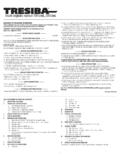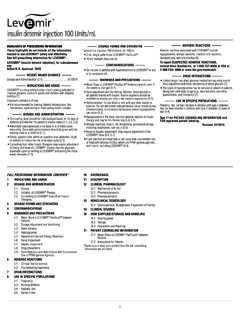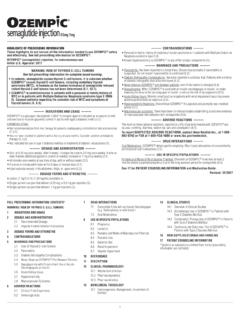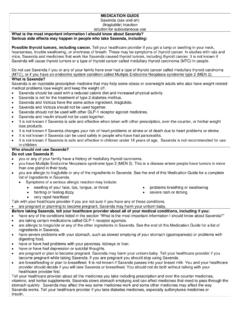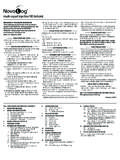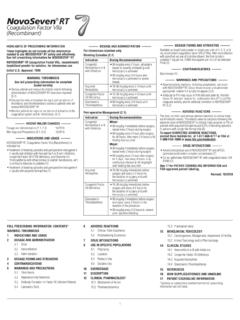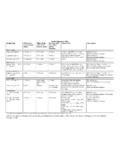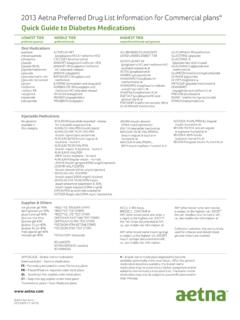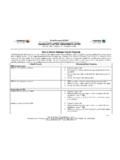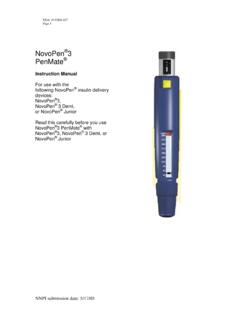Transcription of Novolin N PI
1 1 DOSAGE FORMS AND STRENGTHS Injectable suspension: Novolin N 100 units per mL (U-100) is available as: 10 mL multiple-dose vial (3) 3 mL single-patient-use Novolin N FlexPen (3) CONTRAINDICATIONS During episodes of hypoglycemia (4) Hypersensitivity to Novolin N or any of its excipients (4) WARNINGS AND PRECAUTIONS Never share a Novolin N FlexPen or syringe between patients, even if the needle is changed. ( ) Hyperglycemia or Hypoglycemia with Changes in Insulin Regimen: Make changes to a patient s insulin regimen ( , insulin strength, manufacturer, type, injection site or method of administration) under close medical supervision with increased frequency of blood glucose monitoring. ( ) Hypoglycemia: May be life-threatening. Increase frequency of blood glucose monitoring with changes to: insulin dosage, co-administered glucose lowering medications, meal pattern, physical activity; in patients with renal or hepatic impairment; and in patients with hypoglycemia unawareness.
2 ( ) Hypoglycemia Due to Medication Errors: Accidental mix-ups between insulin products can occur. Instruct patients to check insulin labels before injection. ( ) Hypersensitivity Reactions: Severe, life-threatening, generalized allergy, including anaphylaxis, can occur. Discontinue Novolin N, monitor, and treat if indicated. ( ) Hypokalemia: May be life-threatening. Monitor potassium levels in patients at risk for hypokalemia and treat if indicated. ( ) Fluid Retention and Heart Failure with Concomitant Use of Thiazolidinediones (TZDs): Observe for signs and symptoms of heart failure; consider dosage reduction or discontinuation if heart failure occurs. ( ) ADVERSE REACTIONS Adverse reactions observed with Novolin N include hypoglycemia, allergic reactions, injection site reactions, lipodystrophy, weight gain and edema. (6)To report SUSPECTED ADVERSE REACTIONS, contact Novo Nordisk Inc. at 1-800-727-6500 or FDA at 1-800-FDA-1088 or DRUG INTERACTIONS Drugs that may increase the risk of hypoglycemia: antidiabetic agents, ACE inhibitors, angiotensin II receptor blocking agents, disopyramide, fibrates, fluoxetine, monoamine oxidase inhibitors, pentoxifylline, pramlintide, salicylates, somatostatin analog ( , octreotide), and sulfonamide antibiotics.
3 (7) Drugs that may decrease the blood glucose lowering effect: atypical antipsychotics, corticosteroids, danazol, diuretics, estrogens, glucagon, isoniazid, niacin, oral contraceptives, phenothiazines, progestogens ( , in oral contraceptives), protease inhibitors, somatropin, sympathomimetic agents ( , albuterol, epinephrine, terbutaline), and thyroid hormones. (7) Drugs that may increase or decrease the blood glucose lowering effect: alcohol, beta-blockers, clonidine, lithium salts, and pentamidine. (7) Drugs that may blunt the signs and symptoms of hypoglycemia: beta-blockers, clonidine, guanethidine, and reserpine. (7)See 17 for PATIENT COUNSELING INFORMATION and FDA-approved patient labeling. Revised: 11/201917 PATIENT COUNSELING INFORMATION*Sections or subsections omitted from the full prescribing information are not PRESCRIBING INFORMATION: CONTENTS*1 INDICATIONS AND USAGE2 DOSAGE AND ADMINISTRATION Important Administration Instructions Dosage Information Dosage Adjustment due to Drug Interactions Instructions for Mixing with Other Insulins3 DOSAGE FORMS AND STRENGTHS4 CONTRAINDICATIONS5 WARNINGS AND PRECAUTIONS Never Share a Novolin N FlexPen or Syringe between Patients Hyperglycemia or Hypoglycemia with Changes in Insulin Regimen Hypoglycemia Hypoglycemia Due to Medication Errors Hypersensitivity and Allergic Reactions Hypokalemia Fluid Retention and Heart Failure with Concomitant Use of PPAR-gamma agonists6 ADVERSE REACTIONS7 DRUG INTERACTIONS8 USE IN SPECIFIC POPULATIONS Pregnancy Lactation Pediatric Use Geriatric Use Renal Impairment Hepatic Impairment10 OVERDOSAGE11 DESCRIPTION12 CLINICAL PHARMACOLOGY Mechanism of Action Pharmacodynamics Pharmacokinetics13
4 NONCLINICAL TOXICOLOGY Carcinogenesis, Mutagenesis, Impairment of Fertility16 HOW SUPPLIED/STORAGE AND HANDLING How Supplied Storage and HandlingHIGHLIGHTS OF PRESCRIBING INFORMATIONT hese highlights do not include all the information needed to use Novolin N safely and effectively. See full prescribing information for Novolin N (isophane insulin human suspension), for subcutaneous use Initial Approval: 1991 RECENT MAJOR CHANGES Dosage and Administration ( )------------------11/2019 Warnings and Precautions ( ) -------------------11/2019 INDICATIONS AND USAGE Novolin N is an intermediate-acting human insulin indicated to improve glycemic control in adults and pediatric patients with diabetes mellitus. (1) DOSAGE AND ADMINISTRATION See Full Prescribing Information for important administration instructions. ( ) Inject subcutaneously in abdominal wall, thigh, upper arm, or buttocks and rotate injection sites to reduce the risk of lipodystrophy and localized cutaneous amyloidosis.
5 ( ) Individualize and adjust dosage based on metabolic needs, blood glucose monitoring results and glycemic control goal. ( ) Administer Novolin N once or twice daily. ( ) In patients with type 1 diabetes, Novolin N should generally be used in regimens that include a short-acting insulin.( ) Novolin N can be mixed with regular human insulin. ( )2 Novolin N (isophane insulin human suspension) 100 HypokalemiaAll insulins, including Novolin N, cause a shift in potassium from the extracellular to intracellular space, possibly leading to hypokalemia. Untreated hypokalemia may cause respiratory paralysis, ventricular arrhythmia, and death. Monitor potassium levels in patients at risk for hypokalemia if indicated ( , patients using potassium-lowering medications, patients taking medications sensitive to serum potassium concentration). Fluid Retention and Heart Failure with Concomitant Use of PPAR-gamma agonistsThiazolidinediones (TZDs), which are peroxisome proliferator-activated receptor (PPAR)-gamma agonists, can cause dose-related fluid retention, particularly when used in combination with insulin.
6 Fluid retention may lead to or exacerbate heart failure. Patients treated with insulin, including Novolin N, and a PPAR-gamma agonist should be observed for signs and symptoms of heart failure. If heart failure develops, it should be managed according to current standards of care, and discontinuation or dose reduction of the PPAR-gamma agonist must be ADVERSE REACTIONSThe following adverse reactions are also discussed elsewhere in the labeling: Hypoglycemia [see Warnings and Precautions ( )] Medication Errors [see Warnings and Precautions ( )] Hypersensitivity Reactions [see Warnings and Precautions ( )] Hypokalemia [see Warnings and Precautions ( )]Adverse Reactions from Clinical Studies or Postmarketing ReportsThe following additional adverse reactions have been identified during clinical studies or from postmarketing reports with use of Novolin N. Because some of these reactions are reported voluntarily from a population of uncertain size, it is not always possible to reliably estimate their frequency or to establish a causal relationship to drug reactions associated with insulin initiation and glucose control intensificationIntensification or rapid improvement in glucose control has been associated with a transitory, reversible ophthalmologic refraction disorder, worsening of diabetic retinopathy, and acute painful peripheral neuropathy.
7 Over the long-term, improved glycemic control decreases the risk of diabetic retinopathy and reactionsSevere, life-threatening, generalized allergy, including is the most commonly observed adverse reaction in Novolin N can cause a shift in potassium from the extracellular to intracellular space, possibly leading to site reactionsNOVOLIN N can cause local injection site reactions including redness, swelling, or itching at the site of injection. These reactions usually resolve in a few days to a few weeks, but in some occasions, may require discontinuation. Localized reactions and generalized myalgias have been reported with the use of metacresol, which is an excipient in Novolin of insulin subcutaneously, including Novolin N, has resulted in lipoatrophy (depression in the skin) or lipohyper-trophy (enlargement or thickening of tissue) [see Dosage and Administration ( )] in some Cutaneous AmyloidosisLocalized cutaneous amyloidosis at the injection site has occurred.
8 Hyperglycemia has been reported with repeated insulin injections into areas of localized cutaneous amyloidosis; hypoglycemia has been reported with a sudden change to an unaffected injection ErrorsMedication errors in which other insulins have been accidentally substituted for Novolin N have been identified during postapproval edemaInsulins, including Novolin N, may cause sodium retention and edema, particularly if previously poor metabolic control is improved by intensified insulin WARNINGS AND Never Share a Novolin N FlexPen or Syringe between PatientsNOVOLIN N FlexPen must never be shared between patients, even if the needle is changed. Patients using Novolin N vials must never share needles or syringes with another person. Sharing poses a risk for transmission of blood-borne Hyperglycemia or Hypoglycemia with Changes in Insulin Regimen Changes in an insulin regimen ( , insulin strength, manufacturer, type, injection site or method of administration) may affect glycemic control and predispose to hypoglycemia [see Warnings and Precautions ( )] or hyperglycemia.
9 Repeated insulin injections into areas of lipodystrophy or localized cutaneous amyloidosis have been reported to result in hyperglycemia; and a sudden change in the injection site (to an unaffected area) has been reported to result in hypoglycemia [see Adverse Reactions (6)]. Make any changes to a patient s insulin regimen under close medical supervision with increased frequency of blood glucose monitoring. Advise patients who have repeatedly injected into areas of lipodystrophy or localized cutaneous amyloidosis to change the injection site to unaffected areas and closely monitor for hypoglycemia. For patients with type 2 diabetes, dosage adjustments of concomitant anti-diabetic products may be HypoglycemiaHypoglycemia is the most common adverse reaction of all insulin therapies, including Novolin N. Severe hypoglycemia can cause seizures, may lead to unconsciousness may be life threatening or cause death.
10 Hypoglycemia can impair concentration ability and reaction time; this may place an individual and others at risk in situations where these abilities are important ( , driving or operating other machinery).Hypoglycemia can happen suddenly and symptoms may differ in each individual and change over time in the same individual. Symptomatic awareness of hypoglycemia may be less pronounced in patients with longstanding diabetes in patients with diabetic nerve disease, in patients using medications that block the sympathetic nervous system ( , beta-blockers) [see Drug Interactions (7)], or in patients who experience recurrent Factors for HypoglycemiaThe risk of hypoglycemia after an injection is related to the duration of action of the insulin and, in general, is highest when the glucose lowering effect of the insulin is maximal. As with all insulin preparations, the glucose lowering effect time course of Novolin N may vary in different individuals or at different times in the same individual and depends on many conditions, including the area of injection as well as the injection site blood supply and temperature.
